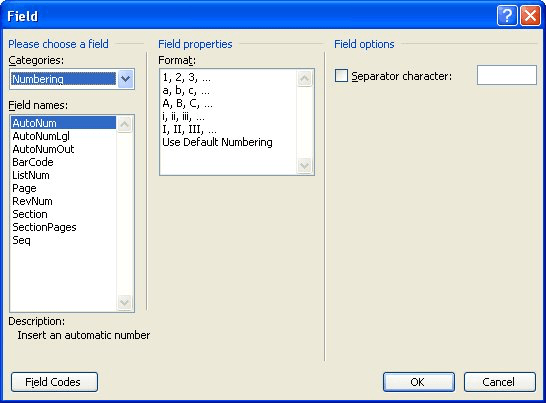Please Note: This article is written for users of the following Microsoft Word versions: 97, 2000, 2002, and 2003. If you are using a later version (Word 2007 or later), this tip may not work for you. For a version of this tip written specifically for later versions of Word, click here: Letters and Numbers in Page Numbers.
Written by Allen Wyatt (last updated October 17, 2020)
This tip applies to Word 97, 2000, 2002, and 2003
In many documents you may have a need to number your pages with a section number as a preface. For instance, you may want them numbered as A-1, A-2, A-3, etc. Exactly how you do this depends on how you have your documents set up. For instance, if each "section" is actually a different document file, then you simply need to set your page numbers this way:
If all the sections of your manuscript are in a single document file, just make sure you have a real section break between each of your sections. You can then set up your page numbers this way:

Figure 1. The Field dialog box.
WordTips is your source for cost-effective Microsoft Word training. (Microsoft Word is the most popular word processing software in the world.) This tip (603) applies to Microsoft Word 97, 2000, 2002, and 2003. You can find a version of this tip for the ribbon interface of Word (Word 2007 and later) here: Letters and Numbers in Page Numbers.

Do More in Less Time! An easy-to-understand guide to the more advanced features available in the Microsoft 365 version of Word. Enhance the quality of your documents and boost productivity in any field with this in-depth resource. Complete your Word-related tasks more efficiently as you unlock lesser-known tools and learn to quickly access the features you need. Check out Microsoft 365 Word For Professionals For Dummies today!
Don't like the font that Word uses for a default in your new documents? You can pick a different font, but the way you ...
Discover MoreVertical lines are even easier to add around a word than are horizontal lines. There are a variety of methods you can use ...
Discover MoreCreate a document in one version of Word on one machine and then open that document in a different version of Word on a ...
Discover MoreFREE SERVICE: Get tips like this every week in WordTips, a free productivity newsletter. Enter your address and click "Subscribe."
There are currently no comments for this tip. (Be the first to leave your comment—just use the simple form above!)
Got a version of Word that uses the menu interface (Word 97, Word 2000, Word 2002, or Word 2003)? This site is for you! If you use a later version of Word, visit our WordTips site focusing on the ribbon interface.
Visit the WordTips channel on YouTube
FREE SERVICE: Get tips like this every week in WordTips, a free productivity newsletter. Enter your address and click "Subscribe."
Copyright © 2026 Sharon Parq Associates, Inc.
Comments